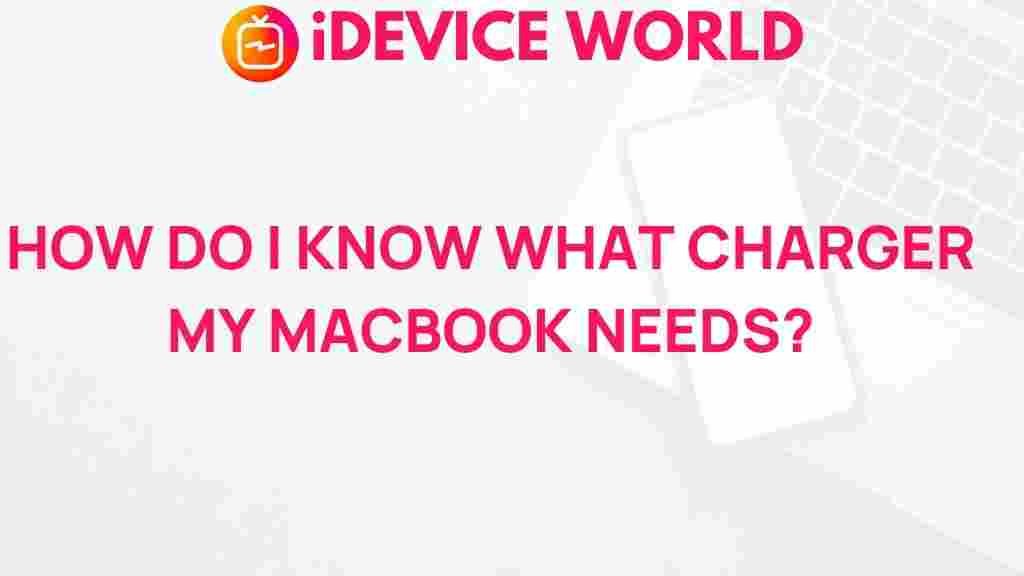MacBook: Unveiling the Mystery of Charger Compatibility
The MacBook has become an essential device for millions of users worldwide, renowned for its sleek design and powerful performance. However, one question often perplexes both new and experienced users alike: which charger is compatible with their MacBook? Understanding charger compatibility is crucial not only for ensuring optimal performance but also for protecting your device from potential damage. In this article, we will unravel the complexities of MacBook charger compatibility, providing you with clear guidelines, troubleshooting tips, and essential information to make informed decisions.
Understanding MacBook Charger Types
Before diving into compatibility issues, it is essential to familiarize yourself with the various types of chargers used with MacBooks. Apple has produced several MacBook models, each requiring different charging solutions. Here’s a breakdown:
- MagSafe Chargers: Introduced with earlier MacBook models, these chargers feature a magnetic connector that easily snaps into place, minimizing the risk of accidental disconnections.
- MagSafe 2 Chargers: An updated version of the original MagSafe, this charger has a thinner design and is compatible with newer MacBook Air and MacBook Pro models.
- USB-C Chargers: The latest MacBook models utilize USB-C technology for charging, offering faster charging speeds and the ability to connect to various peripherals.
Step-by-Step Guide to Determine Charger Compatibility
Determining the right charger for your MacBook can seem daunting, but by following these straightforward steps, you can ensure that you select the appropriate power adapter:
- Identify Your MacBook Model: The first step is to know which MacBook model you own. You can find this information by clicking on the Apple logo in the top-left corner of your screen and selecting “About This Mac.” This will display your MacBook’s specifications, including its model name.
- Check the Charger Requirements: Once you have identified your MacBook model, check the Apple website or your user manual for the specific charger requirements. Different models have varying wattage needs, so it’s important to match your charger accordingly.
- Inspect the Charger Connector: Depending on your MacBook model, the charger connector will vary. Ensure that you have the right type—MagSafe, MagSafe 2, or USB-C—for your device.
- Assess Wattage Compatibility: Each MacBook model requires a specific wattage. Using a charger with a lower wattage than recommended can result in slow charging, while a higher wattage charger can work but may not be optimal. Make sure your charger matches the wattage requirements found in your user manual or on the Apple website.
- Consider Third-Party Chargers: If you are considering purchasing a third-party charger, ensure it is from a reputable brand and certified by Apple. Look for chargers that carry the “MFi” (Made for iPhone/iPad) certification, as these are tested for safety and compatibility.
Common Compatibility Issues
Despite following the steps above, you may still encounter compatibility issues. Here are some common problems and their solutions:
- Charger Not Recognized: If your MacBook does not recognize the charger, try unplugging it and reconnecting it. Additionally, check for debris in the charging port or inspect the connector for damage.
- Slow Charging: If your MacBook charges slowly, ensure you are using the correct wattage charger. A lower wattage charger may lead to prolonged charging times.
- Overheating: If your charger becomes excessively hot, it may be a sign of incompatibility. Discontinue use and consult Apple Support for further assistance.
Troubleshooting Tips
If you encounter issues with your MacBook charger, consider the following troubleshooting tips:
- Reset the System Management Controller (SMC): Resetting the SMC can help resolve power-related issues. To do this, shut down your MacBook, then press and hold the Shift + Control + Option keys along with the power button for 10 seconds. Release all keys and turn on your MacBook.
- Inspect Charging Port: Ensure that the charging port is clean and free from debris. A can of compressed air can help clear out any dust or lint that may be obstructing the connection.
- Try a Different Outlet: Sometimes the issue may not be with the charger itself but rather with the power outlet. Plug your charger into a different outlet to see if that resolves the problem.
- Check for Software Updates: Keeping your macOS up to date can resolve compatibility issues. Go to System Preferences > Software Update to check for available updates.
Choosing the Right Charger: An Overview
When selecting a charger for your MacBook, consider the following factors:
- Original vs. Third-Party: Whenever possible, opt for an original Apple charger. If you choose a third-party option, research the brand thoroughly to ensure it is reliable.
- Wattage: Always verify the wattage requirements for your specific MacBook model to avoid slow charging or potential damage.
- Connector Type: Ensure compatibility with your MacBook’s connector type, whether it be MagSafe, MagSafe 2, or USB-C.
For more information on MacBook accessories and compatibility, visit the official Apple Support website.
Conclusion
Deciphering the MacBook charger compatibility puzzle is crucial for every user who wants to maintain their device’s performance and longevity. By understanding the various charger types, determining compatibility through a systematic approach, and being aware of potential issues, you can ensure that you are using the right charger for your MacBook.
With the right knowledge, you can avoid common pitfalls and enjoy seamless charging experiences. Should you encounter any issues, remember to follow the troubleshooting tips outlined in this article or reach out to Apple Support for further assistance. Keep your MacBook powered and ready for any task, ensuring you make the most out of your device.
This article is in the category Guides & Tutorials and created by iDeciveWorld Team
